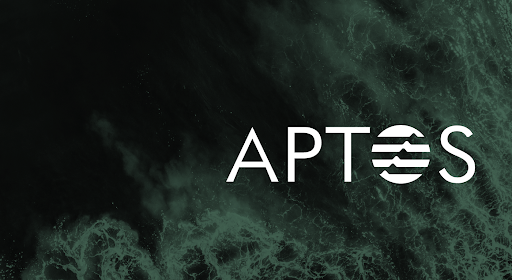Table of Contents
Image source: Aptos
With the launch of its mainnet fast approaching, the Aptos blockchain and its ecosystem is gaining real momentum. In an industry where everyone is on the lookout for the “next big thing”, that means Aptos is also attracting lots of attention from crypto enthusiasts, including investors, developers, users and “hodlers” alike.
There are good reasons why Aptos is currently under the spotlight because it’s a project that promises to deliver much more than just greater scalability and faster transactions, as most other alternative Layer-1 networks promise. Fans of Aptos believe that the blockchain could ultimately even surpass chains such as Ethereum and Solana thanks to its powerful architecture and a strong development team led by Mo Shaikh and Avery Ching, which has tons of experience from working on Facebook’s Diem project in the past.
At present Aptos still has a long way to go, with only its testnet up and running. There’s no token released yet, nor even a whitepaper, but that hasn’t stopped plenty of teams from looking to build upon its platform.
The Power Of Aptos
What we do know about Aptos is that there are compelling reasons to want to build upon it. Like its failed predecessor Diem, Aptos uses the Rust-based Move programming language to underpin its smart contracts. Move has a lot of advantages that Ethereum’s Solidity doesn’t, such as its secure management of resources and simple verification of blockchain commands. Aptos also employs an advanced, low-latency Byzantine Fault Tolerant mechanism that ensures the safety of its network even if its nodes are manipulated by attackers, providing greater safety for the projects and assets building on it.
Other unique characteristics of Aptos include an ability for users to change the private keys to increase their security, and an incredibly high transaction speed that has been shown to reach 125,000 to 150,000 TPS under laboratory conditions. Furthermore, Atmos’s team has stated that upgradeability is a core focus of its efforts, and that they have made it possible to update the core network without the need for downtime, ensuring no disruption in future. Finally, there’s the promise that validators will be able to run diverse nodes at multiple levels.
The Story So Far
Aptos has made significant progress, most especially on the funding front. It made a lot of headlines with its first investment round back in March 2022 when it landed $200 million from big name investors including a16z, Tiger Global, Katie Haun, Multicoin Capital, Three Arrows Capital, FTX Ventures and Coinbase Ventures. That was followed just months later with an additional $150 million in Series A funding from FTX Ventures, Jump Crypto, Apollo, Griffin Gaming Partners, Franklin Templeton, Circle Ventures, Superscrypt, plus two from the initial round (a16z and Multicoin). Since then, it has secured a further, undisclosed investment via Binance Labs, the venture capital arm and accelerator of Binance.
“At Binance, we’ve always believed in the power of blockchain technology to benefit the masses, just like the Internet,” said Head of Binance Labs Yi He. “However, infrastructure building remains a bottleneck within the industry. We believe that the technological competitiveness of the Aptos team could bring increased scalability to the blockchain infrastructure while also supporting novel use cases for Web3."
Aptos has also announced a key partnership with Google Cloud, which is being used as a data store to make it easy for validators to get a node up and running in just 15 minutes.
At the same time, Aptos has developed a reputation for hitting key milestones on its roadmap, which included the launch of its testnet on March 15. That initial launch mainly served as a testing ground to see the Move programming language in action, so it could be refined to make it more developer-friendly. Since then, Aptos has gone on to implement an incentivized testnet, enabling community members to run and use nodes and receive rewards for doing so, as part of a stress test for the network.
The next major milestone for Aptos will be its public mainnet launch later this month, an event that’s hugely anticipated by the growing community.
Concurrent with its ongoing development, Aptos has put an awful lot of effort into growing its community and especially its ecosystem of decentralized applications. Those efforts have really paid off, with Aptos attracting the interest of hundreds of developers from the crypto industry.
One of its most recent coups was the news that Blocto, the popular smart contract wallet, has chosen Aptos as its next major blockchain to integrate with. To date, Blocto has always gone with major networks like Ethereum, Solana, Flow and Tron so its decision to align with Aptos was a major surprise. Given the incredible potential of Aptos though, it could well be an astute move by Blocto, which has ambitions to become the crypto wallet of choice for the Web3 ecosystem.
In a blog post on Medium, Blocto co-founder and Chief Executive Lee Hsuan provided a lengthy explanation of what his company sees in Aptos. He elaborated on the long standing problems with Ethereum’s smart contract programming model that have yet to be resolved despite years of efforts. It’s still up for debate if Ethereum will ever be able to resolve its major issues around security, network congestion and high gas fees, but with Move, Hsuan believes that Aptos seems to have a ready-made solution.
The key advantage of Move is that it handles valuable assets separately as resources, meaning they’re subject to certain restrictions. For instance, Move ensures that resources have guaranteed safety as they can never be copied or dropped. Only certain instructions can create or destroy resources, and those resources can only ever be stored in a user’s storage account. Yet resources can still be used in the same way as other native types, Hsuan explained, for instance stored as data structures and passed as arguments to functions or be returned from functions.
Hsuan argues that these characteristics of Move ensure much greater security as it makes it easier to create smart contracts, with common attacks such as re-entrancy made impossible. There are performance benefits too, he said, thanks to Move’s parallel transaction capabilities, as well as greater “fairness” in terms of storage fee collection.
Blocto is building full functionality for Aptos into its wallet, including support for NFTs, Web3 browsing and native staking, and will also enable users the choice of securing their assets in custodial or non-custodial mode. By providing custodial storage, Blocto can protect user’s assets with its recovery key mechanism.
Blocto might be the biggest name building on Aptos but it’s by far the only one. In particular, Aptos has attracted a lot of interest from DeFi developers, with numerous decentralized exchanges in the works, such as Solrise, Pontem Network, Laminar, Econia, Empo, Hanson and Liquidswap. In addition, the likes of Vial, Njord Finance and Ultima are building lending and borrowing dApps for Aptos.
Aptos’s ecosystem runs the full gamut of projects, with NFT marketplaces such Topaz currently at the devnet stage. Topaz is eagerly awaiting the launch of Aptos’s mainnet, when the APTOS token will become available and its NFT projects can finally come to life.
On the infrastructure front we have plenty of other wallets on Aptos, including names like Coin98, Fewcha and Hive. Other projects include Switchboard, the first oracle building on Aptos, Aptos Name Service, which is building a domain name service for the network, and Dialect, a popular multi-chain messaging project that recently announced its intention to support Aptos.
Recent Developments
One reason for the surge of interest in building on Aptos is its ecosystem grant program, which was announced in June. With it, teams are encouraged to apply for non-dilutive funding to accelerate the development of their projects, so long as they fall into one of several categories. These include projects building developer tooling, such as SDKs, libraries, documentation, guides and tutorials; tools and frameworks for development, governance, DeFi etc; Core protocol contributions such as token standards and upgrades; educational initiatives; and decentralized applications in DeFi, NFTs, social networks, gaming, DAOs, bridging, payments and so on.
In other words, Aptos is using its massive war chest to back just about any project that it thinks might be able to benefit its ecosystem. Indeed, that is one of the key criteria for applicants - that whatever they’re building is able to provide substantial value to its ecosystem. Other rules include an insistence that projects are open-source, and screening for development teams to ensure they’re honest and reliable.
More recently, Aptos announced further strengthening of its ecosystem with a $1 million bug bounty that’s on offer to “white hat” hackers who can find vulnerabilities in its source code. By providing such a huge incentive, Aptos is showing that it’s deadly serious about providing a stable blockchain platform for smart contract developers. The bug bounty will reward anyone who can find “critical” bugs that could lead to severe network downtime, damage or loss of funds, and is open to anyone in the world except those from U.S.-sanctioned countries - namely Russia, Iran, North Korea and Myanmar.
What’s Next For Aptos?
Aptos has hit the ground running and it ticks a lot of boxes that would indicate it is a deadly serious project in the making. It has attracted a lot of interest from developers in key areas such as DeFi, including DEXs and lending dApps, and basic infrastructure, like oracles and wallets.
One thing it lacks currently is a bridge-focused project that would provide interoperability with more established networks, which some might see as a cause for concern. That said, if Aptos lives up to its potential then someone will almost certainly look to build one soon. In any case, Aptos has not failed to attract the attention of projects from other blockchains, with the likes of Blocto, Pontem Network and Solrise all committing to building on its platform. There’s every reason to think its ecosystem will continue expanding too. Thanks to its heavy backing from investors, Aptos has plenty of cash to entice developers through its recently established grants program.
Given that Aptos is reliant on Move, an unfamiliar programming language for many developers, we can expect its team to do promotional and educational work in this area, so expect some kind of hackathon announcement or the availability of new developer tools to make it easier to build on Aptos.
Of course, the big development that everyone’s looking forward to is the launch of the Aptos mainnet that’s scheduled to go live later this month. This will be the most dramatic step forward Aptos has made so far and an event that’s going to be keenly watched. With the launch, Aptos will finally be able to debut its native token APTOS, which we can expect to be listed on multiple CEXs and DEXs. That will be followed by a wave of NFT projects and dApps launching on Aptos, bringing its ecosystem to life.
Given all of the noise Aptos has made so far, the day its mainnet goes live promises to be a momentous occasion for the crypto industry. Users will be able to enjoy their first hands-on experience with a revolutionary programming foundation that promises to transform blockchain security and scalability.
If everything goes as planned, we can expect to see a lot more headlines about Aptos in the months to come.
Disclaimer: This article is provided for informational purposes only. It is not offered or intended to be used as legal, tax, investment, financial, or other advice












